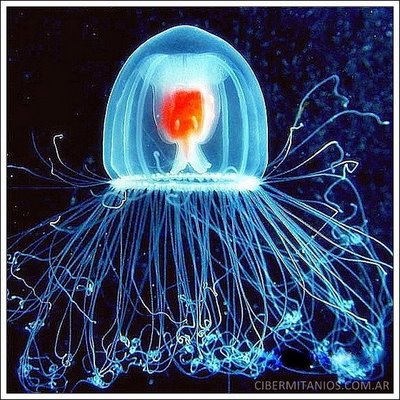Humans have long been fascinated by the concept of immortality. Our most enduring myths recount the search for fountains, elixirs, holy grails, and other elusive means thought to confer of the gift of eternal life.
It has always been the stuff of legend. Then, in the summer of ‘88, a German marine biology student named Christian Sommer discovered something curious about a little-known species of jellyfish: ‘Turritopsis’ had evolved to self-regenerate—and thereby gained eternal life.
A Fate Better Than Death

Turritopsis nutricula - the immortal jellyfish (Photo credit: cibermitanios.com.ar)
Sommer transported the cute little hydroid to his lab for observation. There, what he observed didn’t make any sense. The petite organism seemed to be aging in reverse, growing younger by the day until, finally, it was ‘reborn’ and grew up all over again. Though Sommer didn’t really understand what he was seeing, a handful of Italian scientists caught wind of the discovery. Intrigued, they took up its investigation.
Polyp Jello
By 1996, the Italians had worked out a summary description of what was going on. They informed the scientific community that Turritopsis had the extraordinary ability to revert to polyp-hood at any stage of its development, as needed. Apparently, this meant the creature didn’t have to die. Instead of aging, it simply rejuvenated itself, re-setting its biological clock and starting fresh.
Other jellyfish species tend to perish after the adult medusa spawns eggs or sperm in the name of the next generation. Turritopsis, however, cheats death and linear time through a remarkably simple process.
First, it goes limp and allows itself to sink to the seafloor. There, it curls up into a ball and begins to re-absorb itself, eventually breaking down into what appears to be a jellyfish jello mould, which scientists call a “polyp colony.” After a few days, the pile of jellyfish gradually grows an outer shell. Then it sprouts “stolons”—elongated shoots destined to become a new polyp, which will in turn re-grow and rejuvenate itself over another life cycle.
Discovery of Nuclear Reprogramming
This new spin on metamorphosis, dubbed “transdifferentiation,” didn’t initially make headlines outside scientific circles, despite suggesting the possibility of learning the formula for eternal life. The alchemistic invertebrate might have earned the limelight right away if the mechanisms of its anti-aging formula were at all understood. But for years, there were only endless questions without any good answers. Only in the last decade has progress been made in our understanding of this species’ mystifying longevity.
Today, we know the immortal jellyfish depends on a process known as cell reprogramming. Most of what we know about it comes from stem cell research—especially the work of Shinya Yamanaka and Sir John Gurdon, whose unearthing of transdifferentiating nuclei earned them the 2012 Nobel Prize in Medicine.
Bonus Facts To Arouse Your Curiosity###
Invasion of the Immortal JelliesKnowing how the immortal jellyfish bypasses mortality helps explain how it has taken over the world’s oceans. The Caribbean-born waif, never more than a fifth-of-an-inch wide or tall, can evidently survive and thrive in a variety of environments partly due to its seemingly magical self-reproductive talents. It’s not clear how long the global “invasion” of these spineless immortals will persist, but Turritopsis seems well-equipped to proliferate without limits for the foreseeable future.
Making Sheep’s Eyes
Sir John Gurdon was a key figure in the biological cloning movement, which ultimately led to Dolly—the famed sheep whose successful genetic replication in the 1990s launched a colorful and irate public discussion on the ethics of cloning biotechnology.
Hope Springs Eternal
Gurdon’s cutting-edge research help to prove that the nucleus inside of a mature cell can be modified to generate an embryonic cell without any loss of the crucial data needed to develop organisms. That’s exactly how Turritopsis reconstitutes itself for self-posterity. Stay tuned for research developments in the years to come. Progress in the emerging science of regenerative medicine is sure to reveal whether the immortal jelly can help solve any of the perennial puzzles of human healing.